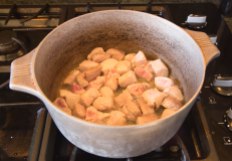Whenever our children visit us with their families, as they did this Christmas season, we try to make old favorites from their childhood. Often the food is drawn from the Southwest, but all three of them grew up in Louisiana, so Cajun and Creole dishes are high on the list of favorites. Gumbo is popular, and boiled crawfish in the spring is almost required. Bread pudding and shrimp creole are also on the list, along with red beans and rice.
For as long as anyone can remember, Monday has been laundry day in New Orleans. For as long as anyone can remember, red beans and rice has been the standard Monday supper in New Orleans because it can be started when the wash is started, stirred from time to time during the day, and finished when everyone is ready to gather around the table in the evening. We didn’t live in New Orleans, but the custom is common throughout the entire state of Louisiana.
An essential part of the dish is the meat that is used in the red beans. Traditionally a ham hock is tossed in – mostly for flavor – but also for the morsels of ham that are closest to the bone. Andouille sausage is popular as is Tasso ham. Sometimes you will see whole pork chops swimming in the stew. For this version, I chose boneless pork loin which gives good flavor and tenderness without bones. The chunks of pork fit perfectly on the fork and make a single melt-in-your-mouth bite.
Usually red beans and rice have the spiciness that is famous in Cajun and Creole cooking, but because one of our family members has severe reactions to hot spices, we make it without red pepper or chiles. Not to worry, because it is easy to add your preferred level of hotness at the table with Tabasco or Louisiana hot sauce.
RECIPE
Red Beans and Rice
Ingredients
- 1 pound dry small red beans
- water to cover the beans for cooking
- 3 tablespoons olive oil
- 1 medium onion, chopped
- 3 ribs celery, chopped
- 1 large bell pepper, seeded and membranes removed, chopped
- 2 cloves garlic, minced
- 2 pounds boneless pork loin, cut into ¾ inch cubes
- 1 bunch green scallions including green stems, chopped
- 2 bay leaves or ¼ teaspoon ground bay leaves
- ¼ teaspoon ground thyme
- salt and pepper to taste
- Louisiana hot sauce to taste
- 1 cup long-grain rice, rinsed in a fine sieve with cold water
- 1½ cups water
Method
- Pour the beans into a heavy-bottomed pot and cover with water. Bring to the boil and then reduce heat to a ver slow boil. Cover and cook the beans for 1½ to 2 hours or until they are tender. Stir the bottom occasionally and add more water if needed.
- When the beans are tender, transfer them and the cooking liquid to a large bowl Rinse and dry the pot. Then return the pot to a medium flame and add the olive oil.
- When the olive oil is just shimmering, add the chopped onions, lower the heat and cover so that the onions “sweat” (become soft and translucent and give up some of their moisture). Do not let them brown.
- Remove the lid, turn up the heat to medium and stir in the celery, green pepper, and garlic. Cook, stirring frequently until the vegetables are throughly wilted. Then transfer them and their juices to a plate.
- Return the pot to the stove. Add the cubes of pork and brown them. Use more oil if needed.
- When the meat is evenly browned, return the beans and their liquid, along with the vegetables, and bring the mixture to the boil. Add the scallions, bay leaves, and thyme.
- Simmer the mixture, covered, for an additional hour. Adjust the seasonings with salt, pepper and, if desired, hot sauce. Remove the bay leaves
- While the red beans are cooking, prepare the rice by combining the rice and water in a small covered pot. Bring to the boil. Stir. Cover and reduce the flame to very low. Do not remove the cover, but cook for 20 minutes. Test for doneness. The water should be completely absorbed, and the rice should be fluffy with individual grains.
- Serve by placing a scoop of rice in the middle of a wide-mouthed bowl. Top with the red bean mixture, and serve with additional hot sauce.
Should serve 6 to 8

















































